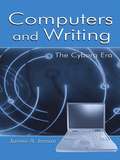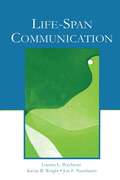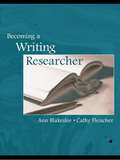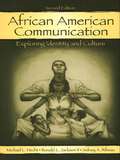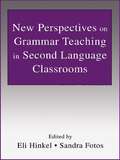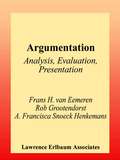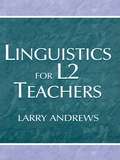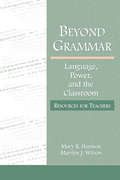- Table View
- List View
Computers and Writing: The Cyborg Era
by James A. InmanIn this book, James A. Inman explores the landscape of the contemporary computers and writing community. Its six chapters engage critical issues, including redefining the community's generally accepted history, connecting its contemporary innovators with its long-standing spirit of innovation, advocating for increased access and diversity, and more. Between chapters, readers will find "Community Voices" sections, which provide a snapshot of the contemporary computers and writing community and introduce, in a non-hierarchical form, more than 100 of its members from around the world, in their own voices. Computers and Writing: The Cyborg Era features a simultaneous emphasis on individuals, communities, and contexts they share; a creative rethinking of the character and values of the computers and writing community; a holistic exploration of meaning-making; and an activist approach to pedagogy. It is a must-read book for anyone interested in rhetoric, technology, and pedagogy, including faculty, graduate students, and colleagues in professions outside the academy.
Life-Span Communication
by Loretta L. Pecchioni Kevin B. Wright Jon F. NussbaumThis innovative text emphasizes how communicative processes develop, are maintained, and change throughout the life span. Topics covered include language skills, interpersonal conflict management, socialization, care-giving, and relationship development. Core chapters examine specific communication processes from infancy through childhood and adolescence into middle age and later life.In its exploration of the role of communication in human development, this volume:*overviews the theoretical and methodological issues related to studying communication across the life span;*discusses foundations of communication: cognitive processes and language;*examines communication in relational contexts and communication competencies;*considers communication in leisure and the media with relevance to the life-span perspective; and*presents the implications of the life-span perspective for future research. This text is intended to be used in life-span communication courses and in interpersonal communication courses with a life-span focus, at an advanced or graduate level. It may also be used in courses on family communication, aging, and language development. It will serve as a supplemental text for courses in psychology, family studies, personal relationships, linguistics, and language studies.
Life-Span Communication
by Loretta L. Pecchioni Kevin B. Wright Jon F. NussbaumThis innovative text emphasizes how communicative processes develop, are maintained, and change throughout the life span. Topics covered include language skills, interpersonal conflict management, socialization, care-giving, and relationship development. Core chapters examine specific communication processes from infancy through childhood and adolescence into middle age and later life.In its exploration of the role of communication in human development, this volume:*overviews the theoretical and methodological issues related to studying communication across the life span;*discusses foundations of communication: cognitive processes and language;*examines communication in relational contexts and communication competencies;*considers communication in leisure and the media with relevance to the life-span perspective; and*presents the implications of the life-span perspective for future research. This text is intended to be used in life-span communication courses and in interpersonal communication courses with a life-span focus, at an advanced or graduate level. It may also be used in courses on family communication, aging, and language development. It will serve as a supplemental text for courses in psychology, family studies, personal relationships, linguistics, and language studies.
Media Psychology
by David GilesMedia Psychology examines the impact that 21st century media use has on human behavior, from teenage crushes on pop stars to soap fandom in adulthood. It brings together North American communication research with European media research in a variety of disciplines--psychology, sociology, communication and media studies--and in doing so, maps out the territory for media psychology. David Giles argues that psychologists have been guilty of ignoring the influence of the media over the last century, seeing it at best as a minor nuisance that will eventually go away. However, with the increasing prevalence of new electronic forms of mass communication, the media seem to have a greater influence than ever over our daily lives. In this book, Dr. Giles tackles the traditional topics of media psychology--sex, violence, advertising--along with sections on developmental aspects of media influence and the psychology of the audience. He also examines a number of specific media genres--news, sports, soaps, and the increasingly popular audience participation media, such as "reality" and "lifestyle" television. In addition, he asks what light psychology can shed on the popularity of these genres and the response of their audiences. Finally, there are chapters on the increasing influence of the Internet and on the representation of psychology and psychologists themselves in the media.
Media Psychology
by David GilesMedia Psychology examines the impact that 21st century media use has on human behavior, from teenage crushes on pop stars to soap fandom in adulthood. It brings together North American communication research with European media research in a variety of disciplines--psychology, sociology, communication and media studies--and in doing so, maps out the territory for media psychology. David Giles argues that psychologists have been guilty of ignoring the influence of the media over the last century, seeing it at best as a minor nuisance that will eventually go away. However, with the increasing prevalence of new electronic forms of mass communication, the media seem to have a greater influence than ever over our daily lives. In this book, Dr. Giles tackles the traditional topics of media psychology--sex, violence, advertising--along with sections on developmental aspects of media influence and the psychology of the audience. He also examines a number of specific media genres--news, sports, soaps, and the increasingly popular audience participation media, such as "reality" and "lifestyle" television. In addition, he asks what light psychology can shed on the popularity of these genres and the response of their audiences. Finally, there are chapters on the increasing influence of the Internet and on the representation of psychology and psychologists themselves in the media.
Becoming a Writing Researcher
by Ann M. Blakeslee Cathy FleischerBecoming a Writing Researcher effectively guides students through the stages of conducting qualitative writing research, from the initial step of seeing themselves as researchers, to identifying research questions, selecting appropriate tools, conducting the research, and interpreting and reporting the findings. Authors Ann M. Blakeslee and Cathy Fleischer describe various qualitative methods and provide readers with examples of real-world applications. Exercises and activities, as well as anecdotes from both novice and seasoned researchers, serve to acquaint readers thoroughly with the practice of carrying out research for scholarly or professional purposes. The textbook introduces students to research methods in a gradual and contextualized manner. Each chapter opens with a discussion of general issues regarding a particular portion of the research process, followed by a consideration of the various physical, conceptual, and strategic tools that allow a beginning researcher to conduct that part of the process. Sections within each chapter also cover: personal and theoretical perspectives and biases that influence specific stages of the research process ethical issues associated with phases of the research process the identity, ethos, and experiences of the researcher. Becoming a Writing Researcher is an essential text for all novice researchers, and is well suited for use in graduate-level research methods courses in composition and technical communication. It is also ideal for use in other disciplines with strong qualitative methodology research programs, including education.
Becoming a Writing Researcher
by Ann M. Blakeslee Cathy FleischerBecoming a Writing Researcher effectively guides students through the stages of conducting qualitative writing research, from the initial step of seeing themselves as researchers, to identifying research questions, selecting appropriate tools, conducting the research, and interpreting and reporting the findings. Authors Ann M. Blakeslee and Cathy Fleischer describe various qualitative methods and provide readers with examples of real-world applications. Exercises and activities, as well as anecdotes from both novice and seasoned researchers, serve to acquaint readers thoroughly with the practice of carrying out research for scholarly or professional purposes. The textbook introduces students to research methods in a gradual and contextualized manner. Each chapter opens with a discussion of general issues regarding a particular portion of the research process, followed by a consideration of the various physical, conceptual, and strategic tools that allow a beginning researcher to conduct that part of the process. Sections within each chapter also cover: personal and theoretical perspectives and biases that influence specific stages of the research process ethical issues associated with phases of the research process the identity, ethos, and experiences of the researcher. Becoming a Writing Researcher is an essential text for all novice researchers, and is well suited for use in graduate-level research methods courses in composition and technical communication. It is also ideal for use in other disciplines with strong qualitative methodology research programs, including education.
African American Communication: Exploring Identity and Culture
by Michael L. Hecht Ronald L. Jackson Sidney A. RibeauWhat communicative experiences are particular to African Americans? How do many African Americans define themselves culturally? How do they perceive intracultural and intercultural communication? These questions are answered in this second edition of African American Communication: Exploring Identity and Culture. Informing multiple audiences interested in African American culture, from cultural researchers and practitioners to educators, policymakers, and community leaders, this innovative and invaluable resource examines the richness and depth of African American communication norms and patterns, as well as African American identities. Positive and healthy African American identities are centrally positioned throughout the book. Applying the cultural contracts theory and the communication theory of identity, authors Michael L. Hecht, Ronald L. Jackson II, and Sidney A. Ribeau explore relationships among African Americans, as well as between African Americans and European Americans, while highlighting the need for sensitivity to issues of power when discussing race, ethnicity, and culture. This wide-ranging volume provides an extensive review of the relevant literature and offers recommendations designed to encourage understanding of African American communication in a context extending beyond Eurocentric paradigms. Considering African American identity with a communicative, linguistic, and relational focus, this volume: *Defines African American identities by describing related terms, such as self, self-concept, personhood and identity; *Explores Afrocentricity and African American discourse; *Examines the status of African Americans in the United States using census statistics and national studies from other research agencies; *Considers identity negotiation and competence; and *Features a full chapter on African American relationships, including gendered, familial, intimate, adolescent and adult, homosexual, friendship, communal, and workplace relationships. African American Communication: Exploring Identity and Culture begins an important dialogue in the communication discipline, intercultural studies, African American studies and other fields concerned with the centrality of culture and communication as it relates to human behavior. It is intended for advanced students and scholars in intercultural communication, interpersonal communication, communication theory, African American/Black studies, social psychology, sociolinguistics, education, and family studies.
African American Communication: Exploring Identity and Culture
by Michael L. Hecht Ronald L. Jackson Sidney A. RibeauWhat communicative experiences are particular to African Americans? How do many African Americans define themselves culturally? How do they perceive intracultural and intercultural communication? These questions are answered in this second edition of African American Communication: Exploring Identity and Culture. Informing multiple audiences interested in African American culture, from cultural researchers and practitioners to educators, policymakers, and community leaders, this innovative and invaluable resource examines the richness and depth of African American communication norms and patterns, as well as African American identities. Positive and healthy African American identities are centrally positioned throughout the book. Applying the cultural contracts theory and the communication theory of identity, authors Michael L. Hecht, Ronald L. Jackson II, and Sidney A. Ribeau explore relationships among African Americans, as well as between African Americans and European Americans, while highlighting the need for sensitivity to issues of power when discussing race, ethnicity, and culture. This wide-ranging volume provides an extensive review of the relevant literature and offers recommendations designed to encourage understanding of African American communication in a context extending beyond Eurocentric paradigms. Considering African American identity with a communicative, linguistic, and relational focus, this volume: *Defines African American identities by describing related terms, such as self, self-concept, personhood and identity; *Explores Afrocentricity and African American discourse; *Examines the status of African Americans in the United States using census statistics and national studies from other research agencies; *Considers identity negotiation and competence; and *Features a full chapter on African American relationships, including gendered, familial, intimate, adolescent and adult, homosexual, friendship, communal, and workplace relationships. African American Communication: Exploring Identity and Culture begins an important dialogue in the communication discipline, intercultural studies, African American studies and other fields concerned with the centrality of culture and communication as it relates to human behavior. It is intended for advanced students and scholars in intercultural communication, interpersonal communication, communication theory, African American/Black studies, social psychology, sociolinguistics, education, and family studies.
New Perspectives on Grammar Teaching in Second Language Classrooms
by Eli Hinkel Sandra FotosNew Perspectives on Grammar Teaching in Second Language Classrooms brings together various approaches to the contextualized teaching of grammar and communicative skills as integrated components of second language instruction. Its purpose is to show from both theoretical and practical perspectives that grammar teaching can be made productive and useful in ESL and EFL classrooms. In this text: *First-rate scholars approach the teaching of grammar from multiple complementary perspectives, providing an original, comprehensive treatment of the topic. *Discourse analysis and research data are used to address such pedagogical areas as grammatical and lexical development in speaking, listening, reading, and writing. *The communicative perspective on ESL and EFL instruction that is presented provides ways for learners to enhance their production skills, whereas the meaning-based grammar instruction can supplement and strengthen current methodology with a communicative focus. This volume is intended as a foundational text for second language grammar pedagogy courses at the advanced undergraduate and master's levels.
New Perspectives on Grammar Teaching in Second Language Classrooms
by Eli Hinkel Sandra FotosNew Perspectives on Grammar Teaching in Second Language Classrooms brings together various approaches to the contextualized teaching of grammar and communicative skills as integrated components of second language instruction. Its purpose is to show from both theoretical and practical perspectives that grammar teaching can be made productive and useful in ESL and EFL classrooms. In this text: *First-rate scholars approach the teaching of grammar from multiple complementary perspectives, providing an original, comprehensive treatment of the topic. *Discourse analysis and research data are used to address such pedagogical areas as grammatical and lexical development in speaking, listening, reading, and writing. *The communicative perspective on ESL and EFL instruction that is presented provides ways for learners to enhance their production skills, whereas the meaning-based grammar instruction can supplement and strengthen current methodology with a communicative focus. This volume is intended as a foundational text for second language grammar pedagogy courses at the advanced undergraduate and master's levels.
Argumentation: Analysis, Evaluation, Presentation
by Frans H. van Eemeren A. Francisca Henkemans Rob GrootendorstThis book concentrates on argumentation as it emerges in ordinary discourse, whether the discourse is institutionalized or strictly informal. Crucial concepts from the theory of argumentation are systematically discussed and explained with the help of examples from real-life discourse and texts. The basic principles are explained that are instrumental in the analysis and evaluation of argumentative discourse. Methodical instruments are offered for identifying differences of opinion, analyzing and evaluating argumentation and presenting arguments in oral and written discourse. In addition, the book provides a great variety of exercises and assignments to improve the students' skill in presenting argumentation. The authors begin their treatment of argumentation theory at the same juncture where argumentation also starts in practice: The difference of opinion that occasions the evolvement of the argumentation. Each chapter begins with a short summary of the essentials and ends with a number of exercises that students can use to master the material. Argumentation is the first introductory textbook of this kind. It is intended as a general introduction for students who are interested in a proper conduct of argumentative discourse. Suggestions for further reading are made for each topic and several extra assignments are added to the exercises. Special features: * A concise and complete treatment of both the theoretical backgrounds and the practice of argumentation analysis and evaluation. * Crucial concepts from pragmatics (speech act theory, Grice's cooperative principle) presented in a non-technical way; introducing the theory of verbal communication. * Unique coverage of both oral and written presentation of arguments. * Exercises and assignments based on real-life texts from a variety of contexts.
Argumentation: Analysis, Evaluation, Presentation
by Frans H. van Eemeren A. Francisca Henkemans Rob GrootendorstThis book concentrates on argumentation as it emerges in ordinary discourse, whether the discourse is institutionalized or strictly informal. Crucial concepts from the theory of argumentation are systematically discussed and explained with the help of examples from real-life discourse and texts. The basic principles are explained that are instrumental in the analysis and evaluation of argumentative discourse. Methodical instruments are offered for identifying differences of opinion, analyzing and evaluating argumentation and presenting arguments in oral and written discourse. In addition, the book provides a great variety of exercises and assignments to improve the students' skill in presenting argumentation. The authors begin their treatment of argumentation theory at the same juncture where argumentation also starts in practice: The difference of opinion that occasions the evolvement of the argumentation. Each chapter begins with a short summary of the essentials and ends with a number of exercises that students can use to master the material. Argumentation is the first introductory textbook of this kind. It is intended as a general introduction for students who are interested in a proper conduct of argumentative discourse. Suggestions for further reading are made for each topic and several extra assignments are added to the exercises. Special features: * A concise and complete treatment of both the theoretical backgrounds and the practice of argumentation analysis and evaluation. * Crucial concepts from pragmatics (speech act theory, Grice's cooperative principle) presented in a non-technical way; introducing the theory of verbal communication. * Unique coverage of both oral and written presentation of arguments. * Exercises and assignments based on real-life texts from a variety of contexts.
Integrating Multiple Literacies in K-8 Classrooms: Cases, Commentaries, and Practical Applications
by Janet C. Richards Michael C. McKennaThis text gives prospective and practicing teachers a comprehensive understanding of how to teach multiple literacies in elementary and middle school classrooms. All of the literacies--dance, music, visual arts, popular culture, media, and computer technologies--are integrated with reading and writing. Balanced treatment is given to theoretical perspectives and practical applications. The text features authentic cases written by preservice teachers, and commentaries on the cases from practitioners and university professors. The cases are designed to prepare future teachers for the PRAXIS teacher certifying exam and others offered in many states. Three theoretical chapters support the practical applications: *Chapter 1 addresses the benefits of writing and analyzing cases and the specific attributes of exemplary teaching cases, and offers guidelines for teachers to author their own case narratives and questions for analyzing and discussing case issues with peers. *Chapter 2 discusses the role of electronic symbol making and multiple sign systems in children's literacy and how children use symbols to receive and express meaning. *Chapter 3 offers a theoretical framework that helps define and enable teachers to use the new literacies of Internet technology, and provides a strong rationale for expanding traditional definitions of literacy. The practical applications chapters (chaps. 4-12) gradually lead readers toward a deeper understanding of how to conceptualize and structure more complex, integrated lessons. In each of these chapters: *An "Overview" provides up-to-date information about the particular form of literacy discussed in the chapter. *A helpful "What Do You Need to Know and How Do You Begin" section offers ideas and tasks for teachers who wish to nurture their artistic and technological aptitudes, expand their understanding of popular culture media, and increase their knowledge about integrating diverse communication forms into cohesive themed units or instruction. *Exemplary cases--the heart of these chapters--present preservice teachers' candid descriptions of their reflections, confusions, and concerns as they support K-8 students writing and writing development through multiple literacy approaches. *Case-specific questions encourage readers to take an active part in analyzing, documenting, and discussing the particular issues raised. *"Commentaries" by skilled practitioners and university professors provide sound teaching suggestions, scholarly perspectives, and sometimes contrasting solutions to the dilemmas described in the cases. *"Reflections and Explorations" activities help teachers become more actively involved in thinking and learning about multiple literacies. *"Practical Applications" questions engage teachers in considering their own teaching environments and goals as they integrate multiple literacy lessons into their curriculum. *"Suggested Readings" support teachers in constructing more in-depth knowledge about the chapter topics.
Integrating Multiple Literacies in K-8 Classrooms: Cases, Commentaries, and Practical Applications
by Janet C. Richards Michael C. McKennaThis text gives prospective and practicing teachers a comprehensive understanding of how to teach multiple literacies in elementary and middle school classrooms. All of the literacies--dance, music, visual arts, popular culture, media, and computer technologies--are integrated with reading and writing. Balanced treatment is given to theoretical perspectives and practical applications. The text features authentic cases written by preservice teachers, and commentaries on the cases from practitioners and university professors. The cases are designed to prepare future teachers for the PRAXIS teacher certifying exam and others offered in many states. Three theoretical chapters support the practical applications: *Chapter 1 addresses the benefits of writing and analyzing cases and the specific attributes of exemplary teaching cases, and offers guidelines for teachers to author their own case narratives and questions for analyzing and discussing case issues with peers. *Chapter 2 discusses the role of electronic symbol making and multiple sign systems in children's literacy and how children use symbols to receive and express meaning. *Chapter 3 offers a theoretical framework that helps define and enable teachers to use the new literacies of Internet technology, and provides a strong rationale for expanding traditional definitions of literacy. The practical applications chapters (chaps. 4-12) gradually lead readers toward a deeper understanding of how to conceptualize and structure more complex, integrated lessons. In each of these chapters: *An "Overview" provides up-to-date information about the particular form of literacy discussed in the chapter. *A helpful "What Do You Need to Know and How Do You Begin" section offers ideas and tasks for teachers who wish to nurture their artistic and technological aptitudes, expand their understanding of popular culture media, and increase their knowledge about integrating diverse communication forms into cohesive themed units or instruction. *Exemplary cases--the heart of these chapters--present preservice teachers' candid descriptions of their reflections, confusions, and concerns as they support K-8 students writing and writing development through multiple literacy approaches. *Case-specific questions encourage readers to take an active part in analyzing, documenting, and discussing the particular issues raised. *"Commentaries" by skilled practitioners and university professors provide sound teaching suggestions, scholarly perspectives, and sometimes contrasting solutions to the dilemmas described in the cases. *"Reflections and Explorations" activities help teachers become more actively involved in thinking and learning about multiple literacies. *"Practical Applications" questions engage teachers in considering their own teaching environments and goals as they integrate multiple literacy lessons into their curriculum. *"Suggested Readings" support teachers in constructing more in-depth knowledge about the chapter topics.
Community Writing: Researching Social Issues Through Composition
by Paul S. CollinsCommunity Writing: Researching Social Issues Through Composition employs a series of assignments that guide students to research and write about issues confronting their individual communities. Students start by identifying a community to which they belong and focusing on problems in it, and then analyze possible solutions, construct arguments for them, decide which are likely to succeed, and consider how to initiate action. This is a primary text for first-year composition courses, covering the basics of the writing process. The assignments are recursive. Short writing assignments in each chapter build up to longer papers. Each of the assignment questions is accompanied by a guide to thinking about and writing the assigned paper, followed by a short Focus On reading that provides a brief account of community activism, a media case study, or a notable success story. The longer papers are accompanied by in-class peer reading groups. Each successive peer reading attempts a higher level of conceptual critique. By working together throughout the semester, students create increasingly adept peer groups familiar with all stages of each other's research. The book is carefully structured, but there is plenty of "give" in it, allowing instructors to be flexible in adapting it to the needs of their students and courses. Community Writing: * is distinguished by pedagogy based on a collaborative, process-oriented, service learning approach that emphasizes media critique and field research on community issues chosen by individual students; * answers real student questions, such as: Where do I find articles on my topic? What if evidence contradicts my hypothesis? How do I know if a source is biased?; * is web-savvy--guides students into building their own Web sites, including a unique guide for critiquing the design and veracity of other people's websites; and * is media-savvy--topics include media monopolies, spin control, dumbing down, misleading statistics, the Freedom of Information Act, "crackpot" authors, political rhetoric, and fallacious argumentation.
Community Writing: Researching Social Issues Through Composition
by Paul S. CollinsCommunity Writing: Researching Social Issues Through Composition employs a series of assignments that guide students to research and write about issues confronting their individual communities. Students start by identifying a community to which they belong and focusing on problems in it, and then analyze possible solutions, construct arguments for them, decide which are likely to succeed, and consider how to initiate action. This is a primary text for first-year composition courses, covering the basics of the writing process. The assignments are recursive. Short writing assignments in each chapter build up to longer papers. Each of the assignment questions is accompanied by a guide to thinking about and writing the assigned paper, followed by a short Focus On reading that provides a brief account of community activism, a media case study, or a notable success story. The longer papers are accompanied by in-class peer reading groups. Each successive peer reading attempts a higher level of conceptual critique. By working together throughout the semester, students create increasingly adept peer groups familiar with all stages of each other's research. The book is carefully structured, but there is plenty of "give" in it, allowing instructors to be flexible in adapting it to the needs of their students and courses. Community Writing: * is distinguished by pedagogy based on a collaborative, process-oriented, service learning approach that emphasizes media critique and field research on community issues chosen by individual students; * answers real student questions, such as: Where do I find articles on my topic? What if evidence contradicts my hypothesis? How do I know if a source is biased?; * is web-savvy--guides students into building their own Web sites, including a unique guide for critiquing the design and veracity of other people's websites; and * is media-savvy--topics include media monopolies, spin control, dumbing down, misleading statistics, the Freedom of Information Act, "crackpot" authors, political rhetoric, and fallacious argumentation.
Linguistics for L2 Teachers
by Larry AndrewsLinguistics for L2 Teachers is designed to help bilingual and ESL teachers better understand how and why the English language works, and to broaden their abilities to help their students learn about the various functions of English in the real world. It is not a complete curriculum in English linguistics, but rather, a foundation from which teachers can continue to grow and to teach with greater confidence. The reader-friendly, conversational style makes the concepts easily accessible to preservice and in-service teachers who have little or no previous experience in language study. This textbook: * explains various aspects of English using non-technical terminology; * goes beyond the study of grammar to examine the functions of language, not just its form; * presents language applications in L2 classrooms; and * clearly delineates the significance of chapter topics for L2 teachers and students. Each chapter includes prereading activities to enhance the reader's comprehension; postreading activities to expand and elaborate the concepts; and interactive "Be A Linguist" activities to help readers think in ways similar to the ways linguists think and to provide opportunities to apply ideas explained within the chapter. Intended for all teachers of students for whom English is a new language, this text will help them be better prepared to meet the important challenges and questions they encounter in their classrooms.
Linguistics for L2 Teachers
by Larry AndrewsLinguistics for L2 Teachers is designed to help bilingual and ESL teachers better understand how and why the English language works, and to broaden their abilities to help their students learn about the various functions of English in the real world. It is not a complete curriculum in English linguistics, but rather, a foundation from which teachers can continue to grow and to teach with greater confidence. The reader-friendly, conversational style makes the concepts easily accessible to preservice and in-service teachers who have little or no previous experience in language study. This textbook: * explains various aspects of English using non-technical terminology; * goes beyond the study of grammar to examine the functions of language, not just its form; * presents language applications in L2 classrooms; and * clearly delineates the significance of chapter topics for L2 teachers and students. Each chapter includes prereading activities to enhance the reader's comprehension; postreading activities to expand and elaborate the concepts; and interactive "Be A Linguist" activities to help readers think in ways similar to the ways linguists think and to provide opportunities to apply ideas explained within the chapter. Intended for all teachers of students for whom English is a new language, this text will help them be better prepared to meet the important challenges and questions they encounter in their classrooms.
What Writing Does and How It Does It: An Introduction to Analyzing Texts and Textual Practices
by Charles Bazerman Paul PriorIn What Writing Does and How It Does It, editors Charles Bazerman and Paul Prior offer a sophisticated introduction to methods for understanding, studying, and analyzing texts and writing practices. This volume addresses a variety of approaches to analyzing texts, and considers the processes of writing, exploring textual practices and their contexts, and examining what texts do and how texts mean rather than what they mean. Included are traditional modes of analysis (rhetorical, literary, linguistic), as well as newer modes, such as text and talk, genre and activity analysis, and intertextual analysis. The chapters have been developed to provide answers to a specified set of questions, with each one offering:*a preview of the chapter's content and purpose; *an introduction to basic concepts, referring to key theoretical and research studies in the area;*details on the types of data and questions for which the analysis is best used; *examples from a wide-ranging group of texts, including educational materials, student writing, published literature, and online and electronic media; *one or more applied analyses, with a clear statement of procedures for analysis and illustrations of a particular sample of data; and*a brief summary, suggestions for additional readings, and a set of activities. The side-by-side comparison of methods allows the reader to see the multi-dimensionality of writing, facilitating selection of the best method for a particular research question. The volume contributors are experts from linguistics, communication studies, rhetoric, literary analysis, document design, sociolinguistics, education, ethnography, and cultural psychology, and each utilizes a specific mode of text analysis. With its broad range of methodological examples, What Writing Does and How It Does It is a unique and invaluable resource for advanced undergraduate and graduate students and for researchers in education, composition, ESL and applied linguistics, communication, L1 and L2 learning, print media, and electronic media. It will also be useful in all social sciences and humanities that place importance on texts and textual practices, such as English, writing, and rhetoric.
Negotiating Critical Literacies in Classrooms
by Barbara Comber Anne SimpsonNegotiating Critical Literacies in Classrooms brings together accounts of educators who have sought to make a difference in the lives of their students through literacy education--from university classrooms in the United States, England, and South Africa, to policy and curriculum development in Singapore and Australia. Each chapter represents the results of extended research on classroom practice. The authors in this collection write as teachers. The literacy classrooms they explore range from the early years of schooling, to primary and secondary education, through to community and university sites. Although the volume is organized around different levels of education, clearly overlapping themes emerge across the chapters, including identity formation and textual practices, politicizing curriculum and textbook production, and changing the power relations in classroom talk around text. An overarching theme of this collection is the belief that there is no one generic, universal critical literacy--in theory or in practice. Rather, the authors reveal how a range of theories can serve as productive starting points for educators working on social justice agendas through the literacy curriculum, and, equally important, how particular critical literacy theories or pedagogies must be worked out in specific locations. In each of these accounts, educators explain how they have taken a body of theory and worked with and on it in classrooms. Their rich portrayals and narratives of classroom realities illustrate the unanticipated effects of pedagogies that emerge in specific contexts. Experiences from the classrooms have led them to revise theories that are central to critical literacy, including constructs such as "empowerment," "resistance," and "multiple readings." This collection documents what occurs when educators confront the difficult ethical and political issues that evolve in particular classroom situations. Negotiating Critical Literacies in Classrooms is appropriate as a text for courses in language and literacy education, and will be of broad interest to educational researchers, practitioners, and theorists. The practical classroom focus makes this book accessible and of interest to a wide range of teachers and an excellent resource for professional development. The international scope will appeal to a global educational readership.
Negotiating Critical Literacies in Classrooms
by Barbara Comber Anne SimpsonNegotiating Critical Literacies in Classrooms brings together accounts of educators who have sought to make a difference in the lives of their students through literacy education--from university classrooms in the United States, England, and South Africa, to policy and curriculum development in Singapore and Australia. Each chapter represents the results of extended research on classroom practice. The authors in this collection write as teachers. The literacy classrooms they explore range from the early years of schooling, to primary and secondary education, through to community and university sites. Although the volume is organized around different levels of education, clearly overlapping themes emerge across the chapters, including identity formation and textual practices, politicizing curriculum and textbook production, and changing the power relations in classroom talk around text. An overarching theme of this collection is the belief that there is no one generic, universal critical literacy--in theory or in practice. Rather, the authors reveal how a range of theories can serve as productive starting points for educators working on social justice agendas through the literacy curriculum, and, equally important, how particular critical literacy theories or pedagogies must be worked out in specific locations. In each of these accounts, educators explain how they have taken a body of theory and worked with and on it in classrooms. Their rich portrayals and narratives of classroom realities illustrate the unanticipated effects of pedagogies that emerge in specific contexts. Experiences from the classrooms have led them to revise theories that are central to critical literacy, including constructs such as "empowerment," "resistance," and "multiple readings." This collection documents what occurs when educators confront the difficult ethical and political issues that evolve in particular classroom situations. Negotiating Critical Literacies in Classrooms is appropriate as a text for courses in language and literacy education, and will be of broad interest to educational researchers, practitioners, and theorists. The practical classroom focus makes this book accessible and of interest to a wide range of teachers and an excellent resource for professional development. The international scope will appeal to a global educational readership.
Media Sex: What Are the Issues?
by Barrie GunterThis book examines the representation, impact, and issues relating to the control and regulation of sex in the media. It covers work that has been conducted around the world on the depiction of sex in the mainstream mass media, especially the audio-visual media of film, television, and video, and the alleged effects that such content may have upon media consumers. In addition to reviewing the research on the effects of media sex, the book also examines what is known about public opinion concerning sex in the media. A key theme running through the book is whether the evidence about media sex can be taken at face value. Are the methodologies used by researchers to investigate media sex problematic? Have they yielded data that can be questioned in terms of validity and reliability? Media Sex questions whether media sex poses a serious problem for most viewers of mainstream media. It acknowledges that there may be serious issues relating to the causation of public offense and the cultivation of anti-women attitudes and beliefs that need to be addressed in productions where more extreme forms of sexual conduct are combined with violent and sadistic behavior. With the unrelenting growth of media, media consumers demand and are given greater personal control over the reception of media content. The notion of freedom of speech conflicts with the view that media content needs to be centrally regulated and controlled. This conflict creates problems for regulatory organizations and the legislators in nation states in which freedom of the press is legally protected. The book examines the debate surrounding this conflict.
Media Sex: What Are the Issues?
by Barrie GunterThis book examines the representation, impact, and issues relating to the control and regulation of sex in the media. It covers work that has been conducted around the world on the depiction of sex in the mainstream mass media, especially the audio-visual media of film, television, and video, and the alleged effects that such content may have upon media consumers. In addition to reviewing the research on the effects of media sex, the book also examines what is known about public opinion concerning sex in the media. A key theme running through the book is whether the evidence about media sex can be taken at face value. Are the methodologies used by researchers to investigate media sex problematic? Have they yielded data that can be questioned in terms of validity and reliability? Media Sex questions whether media sex poses a serious problem for most viewers of mainstream media. It acknowledges that there may be serious issues relating to the causation of public offense and the cultivation of anti-women attitudes and beliefs that need to be addressed in productions where more extreme forms of sexual conduct are combined with violent and sadistic behavior. With the unrelenting growth of media, media consumers demand and are given greater personal control over the reception of media content. The notion of freedom of speech conflicts with the view that media content needs to be centrally regulated and controlled. This conflict creates problems for regulatory organizations and the legislators in nation states in which freedom of the press is legally protected. The book examines the debate surrounding this conflict.
Beyond Grammar: Resources for Teachers
by Mary R. Harmon Marilyn J. WilsonBeyond Grammar: Language, Power, and the Classroom asks readers to think about the power of words, the power of language attitudes, and the power of language policies as they play out in communities, in educational institutions, and in their own lives as individuals, teachers, and participants in the larger community. Each chapter provides extended discussion of a set of critical language issues that directly affect students in classrooms: the political nature of language, the power of words, hate language and bullying, gender and language, dialects, and language policies. Written for pre-service and practicing teachers, this text addresses how teachers can alert students to the realities of language and power--removing language study from a “neutral” corner to situate it within the context of political, social, and cultural issues. Developing a critical pedagogy about language instruction can help educators understand that classrooms can either maintain existing inequity or address and diminish inequity through critical language study. A common framework structures the chapters of the text: * Each chapter begins with an overview of the language issue in question, and includes references for further research and for classroom use, and provides applications for classroom teachers.* Numerous references to the popular press and the breadth of language issues found therein foreground current thought on socio-cultural language issues, attitudes, standards, and policies found in the culture(s) at large.* References to current and recent events illustrate the language issue’s importance, cartoons address the issue, and brief “For Thought” activities illustrate the point being discussed and extend the reader’s knowledge and awareness.* “Personal Explorations” ask readers to go beyond the text to develop further understanding; “Teaching Explorations” ask teachers to apply chapter content to teaching situations. Beyond Grammar: Language, Power, and the Classroom is intended for undergraduate and master’s level courses that address literacy education, linguistics, and issues of language and culture.
